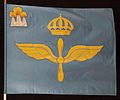Västmanland Air Force Wing
Västmanland Air Force Wing (Swedish: Västmanlands flygflottilj), also F 1 Hässlö, or simply F 1, is a former Swedish Air Force wing with the main base located at Hässlö Airport in Västerås in central Sweden.
| Västmanland Air Force Wing | |
|---|---|
| Västmanlands flygflottilj | |
 | |
| Active | 1929–1983 |
| Country | Sweden |
| Allegiance | Swedish Armed Forces |
| Branch | Swedish Air Force |
| Type | Wing |
| Part of | First Air Group (1938–40, 1942–48) Third Air Group (1948–1966) Eastern Military Area (1966–1974) |
| Garrison/HQ | Västerås |
| Motto(s) | Per aspera ad astra[1] ("Through hardships to the stars") |
| March | "Prinz Friedrich Carl-Marsch" (Bilse)[note 1] |
| Insignia | |
| Roundel |  |
| Aircraft flown | |
| Bomber | B 3, B 4, B 5, B 17, B 18 |
| Fighter | J 1, J 4, J 5, J 6, J 7, J 8, J 30, J 33, J 32B, J 35F |
| Multirole helicopter | Hkp 3B |
| Reconnaissance | S 5, S 6 |
| Trainer | Sk 6, Sk 9, Sk 10, Sk 11, Sk 12, Sk 15, Sk 16, Sk 50 |
| Transport | Tp 5, Tp 7, Tp 9, Tp 83 |
| G 101, Se 102, Se 103, Se 104, A 1, P 1, P 5, Ö 6, Ö 9 | |
History
The 1st Flying Corps was set up near Västerås City on 1 July 1929 on the grounds of the recently disbanded Västmanland Regiment (I 18). The airfield at Hässlö was brought in use in 1931.
In 1936, the 1st Flying Corps was redesignated F 1 as the 1st Air Wing and received B 3 bombers. These were later supplemented with B 4 dive bombers.
In 1949, F 1 was reorganized as a night fighter wing with 60 surplus J 30 De Havilland Mosquitos from England. They were in turn replaced by 60 J 33 Venoms in 1952. All of the J 30 and J 33 in Sweden were based at F 1.
In 1959, the night fighter squadrons were converted to regular fighter squadrons of J 32B. These were in service until 1968 when they were in turn replaced with J 35F until the decommissioning of the wing in 1983.
The airfield is known today as Stockholm-Västerås Airport (IATA: VST, ICAO: ESOW) with daily flights to England and charter to Mediterranean destinations.
Barracks and training areas
Barracks
The unit was from 1927 to 1944 located in the former Västmanland Regiment's (I 18) barracks in Viksäng outside Västerås. Its staff moved on 1 August 1943 to the Hässlö Airfield where new barracks were also ready the following year. The old barracks area was then taken over by the Swedish Air Force Central Ground Training Schools (Flygvapnets centrala skolor, FCS) until their final relocation in 1961 to Halmstad. The wing had one runway in the north-south direction.[3]
 Guardhouse (1979)
Guardhouse (1979)- Guardhouse (2010)
- View of the guardhouse, barracks and rescue station
- Chancellery and traffic control tower (2010)
 The wing and runway (1979) to the north
The wing and runway (1979) to the north The wing and runway seen (2009) to the east
The wing and runway seen (2009) to the east
Training areas
The wing's training areas included Hässlö Airfield from 1931 and Gimpelstenarna in Granfjärden and the southern tip of Kärrbolandet during the 1930s.[3]
Heraldry and traditions
Coat of arms
Blazon: "The provincial badge of Västmanland, a three-pointed mountain argent, flammant proper".[4]
Colours, standards and guidons
A colour was presented to the wing on 16 June 1938 at Gärdet in Stockholm by His Majesty the King Gustaf V on his 80th birthday. At the disbandment of F 1 closure in 1983, it was handed over to the wing's traditional carrier F 16, but is now preserved at the Swedish Army Museum.[5] Blazon: "On blue cloth in the centre the badge of the Air Force; a winged two-bladed propeller under a royal crown proper. In the first corner the provincial badge of Västmanland, a three-pointed mountain, flammant proper".[5]
The colour of Västmanland Regiment (I 18) was used until the regiment was disbanded in 1927.[6] According to government decision on 11 December 1942, the wing would also carry this colour as a traditional colour from 26 September 1943. The colour was presented to the wing on this date by Lieutenant General Richard Åkerman.[5] This colour also included the regimental battle honours, and the wing then became Sweden's only air force wing with battle honours on its colour. The colour was used until Västmanland Air Force Wing was disbanded in 1983.[6]
Svea Air Corps' (F 8) colour was deposited in 1974 at the Västmanland Air Force Wing.[4]
 1938 colour.
1938 colour.
March
”Kungl Västmanlands regementes och flygflottiljs marsch” was composed during the 1880s by Benjamin Bilse under the name "Prinz Friedrich Carl-(Sieges-) Marsch". The march was used by Västmanland Regiment (I 18) from the 1880s, then transferred to the wing and by decision of the Chief of the Army, Lieutenant General Åke Sagrén in 1991, to Västmanland Defence District (Västmanlands försvarsområde, Fo 48) prior to the inauguration of Fo 48's new staff building at Viksäng in Västerås. This unit was from 1 July 1994 again referred to as Västmanland Regiment (Fo 48).[1]
Commanding officers
From 1929 to 1936, the commanding officers was referred to as kårchef ("corps commander") and had the rank of major. When the wing organization was introduced in 1936, the commanding officer was referred to as flottiljchef ("wing commander"), and had the rank of lieutenant colonel. At the end of the 1940s, the wing commander got the rank of colonel. From 1975 to 1981, the wing commander was referred to as sektorflottiljchef ("sector wing commander") and had the rank of colonel 1st class. From 1981 to 1983, the commanding officer was again referred to as flottiljchef ("wing commander"), and had the rank of colonel.
Corps, wing and sector wing commanders
Commanders:[7]
- 1929–1934: Harald Enell
- 1934–1937: Egmont Tornberg
- 1937–1938: Gustav Ström
- 1938–1942: Axel Ljungdahl
- 1942–1945: Gustaf Adolf Westring
- 1945–1950: Arthur Falk
- 1950–1954: Ingvar Berg
- 1954–1959: Gösta Odqvist
- 1959–1964: Henrik Nordström
- 1964–1966: Rolf Svartengren
- 1966–1968: Nils Palmgren
- 1968–1975: Tore Persson
- 1975–1976: Börje Björkholm (acting)
- 1976–1980: Stig Bruse
- 1980–1983: Börje Björkholm
Deputy sector wing commanders
In order to relieve the sector wing commander, a deputy sector wing commander position was added in 1975. Its task was to lead the unit procurement, a task largely similar to the old wing commander position. Hence he was also referred to as flottiljchef ("wing commander"). The deputy sector wing commander had the rank of colonel. On 30 June 1981, the deputy sector wing commander position was terminated.
- 1975–1979: Börje Björkholm
- 1980–1981: Knut Osmund
Names, designations and locations
| Name | Translation | From | To | |
|---|---|---|---|---|
| Första flygkåren | 1st Air Corps | 1929-07-01 | – | 1936-06-30 |
| Kungl. Västmanlands flygflottilj | Royal Västmanland Air Force Wing | 1936-07-01 | – | 1974-12-31 |
| Västmanlands flygflottilj | Västmanland Air Force Wing | 1975-01-01 | – | 1976-12-31 |
| Västmanlands flygflottilj och luftförsvarssektor O5 | Västmanland Air Force Wing and Air Defense Sector O5 | 1977-01-01 | – | 1981-06-30 |
| Västmanlands flygflottilj | Västmanland Air Force Wing | 1981-07-01 | – | 1983-06-30 |
| Designation | From | To | ||
| F 1 | 1929-07-01 | – | 1976-12-31 | |
| F 1/Se O5 | 1977-01-01 | – | 1981-06-30 | |
| F 1 | 1981-07-01 | – | 1983-06-30 | |
| Location | From | To | ||
| Viksäng | 1929-07-01 | – | 1944-07-31 | |
| Västerås (Hässlö) Airport | 1944-08-01 | – | 1983-06-30 |
See also
Footnotes
- The march was adopted and established in 1943. It was used by the Västmanland Regiment from 1993 to 1997 and the Västmanland Group (Västmanlandsgruppen) from 1998 to 2004.[2]
References
Notes
- Braunstein 2005, p. 44
- Sandberg 2007, p. 19
- Braunstein 2005, p. 45
- Braunstein 2005, p. 43
- Braunstein 2005, p. 42
- Braunstein 2003, pp. 81–83
- Braunstein 2005, pp. 45-46
Print
- Braunstein, Christian (2003). Sveriges arméförband under 1900-talet. Skrift / Statens försvarshistoriska museer, 1101-7023 ; 5 (in Swedish). Stockholm: Statens försvarshistoriska museer. ISBN 91-971584-4-5. SELIBR 8902928.
- Braunstein, Christian (2005). Svenska flygvapnets förband och skolor under 1900-talet (PDF). Skrift / Statens försvarshistoriska museer, 1101-7023 ; 8 [dvs 9] (in Swedish). Stockholm: Statens försvarshistoriska museer. ISBN 9197158488. SELIBR 9845891.
- Sandberg, Bo (2007). Försvarets marscher och signaler förr och nu: marscher antagna av svenska militära förband, skolor och staber samt igenkännings-, tjänstgörings- och exercissignaler (in Swedish) (New ed.). Stockholm: Militärmusiksamfundet med Svenskt marscharkiv. ISBN 978-91-631-8699-8. SELIBR 10413065.
Web
- Webpage listing all air force squadrons in Sweden (in Swedish)
Further reading
| Wikimedia Commons has media related to Västmanland Air Force Wing. |
- Odqvist, Gösta, ed. (1979–1985). Kungl. Västmanlands flygflottiljs historia (in Swedish). Västerås. SELIBR 604900.
- Odqvist, Gösta, ed. (1979). Kungl. Västmanlands flygflottiljs historia [D. 1] 1929-1979 (in Swedish). [Västerås]: [Komm.] SELIBR 604901.
- Odqvist, Gösta; Andersson, Uno; Andersson, Stig, eds. (1985). Kungl. Västmanlands flygflottiljs historia D. 2 1979-1983 (1985) (in Swedish). Västerås: Västmanlands regementes och flygflottiljs kamratfören. SELIBR 604902.